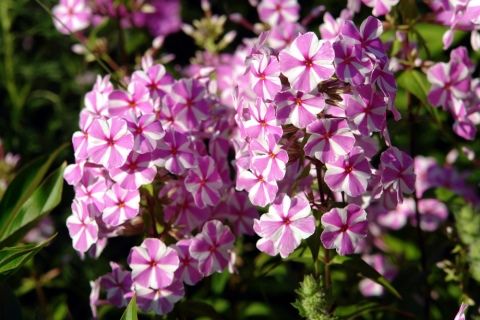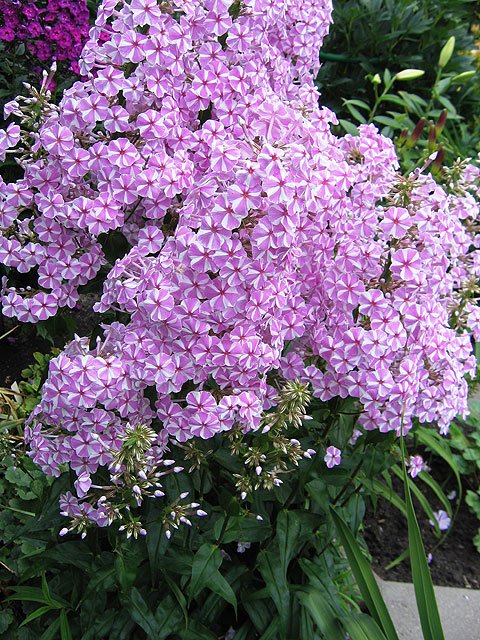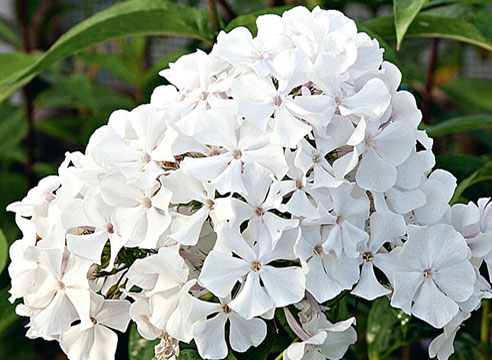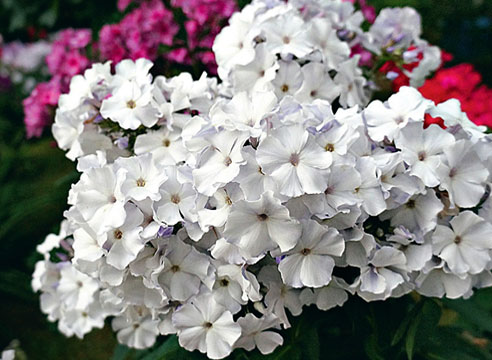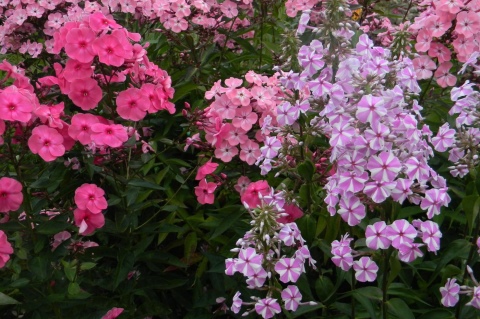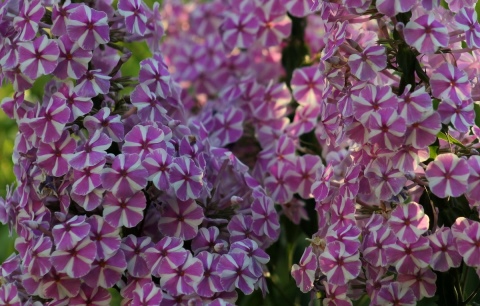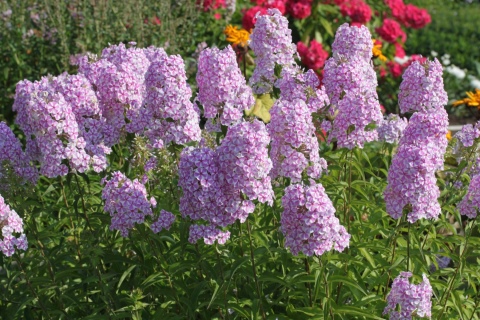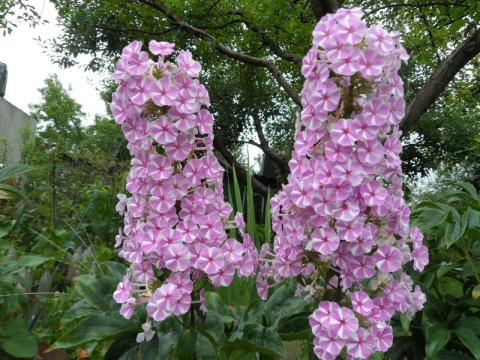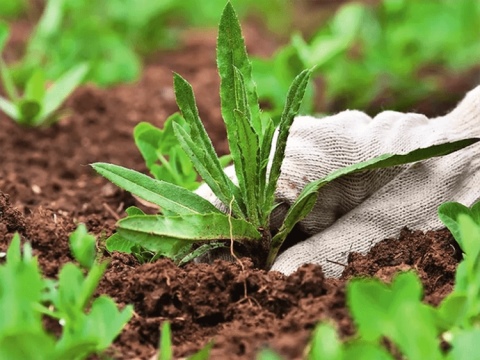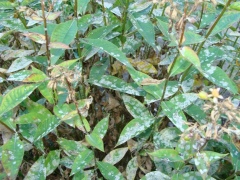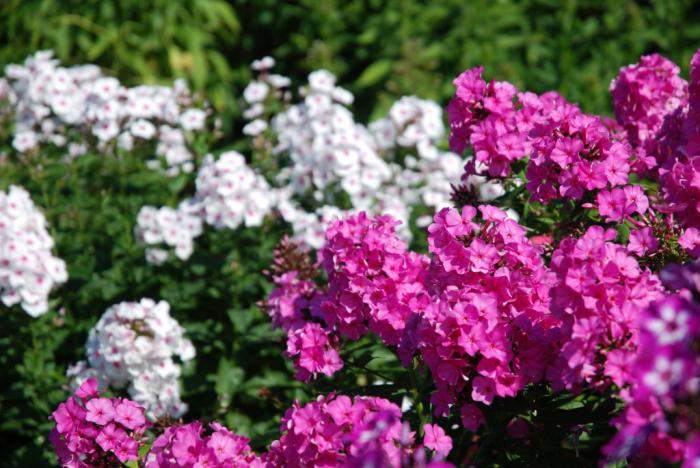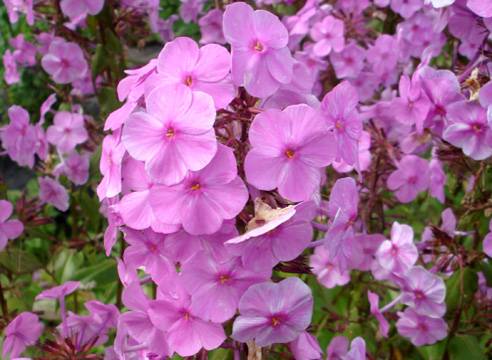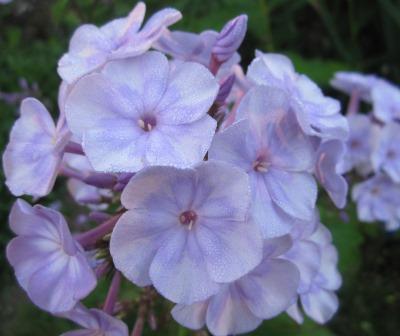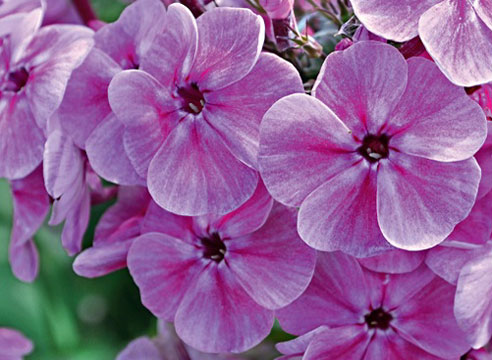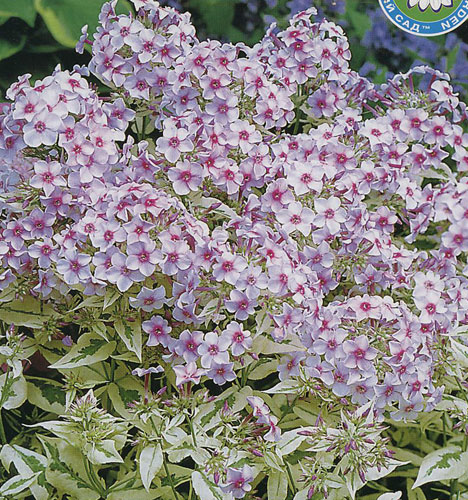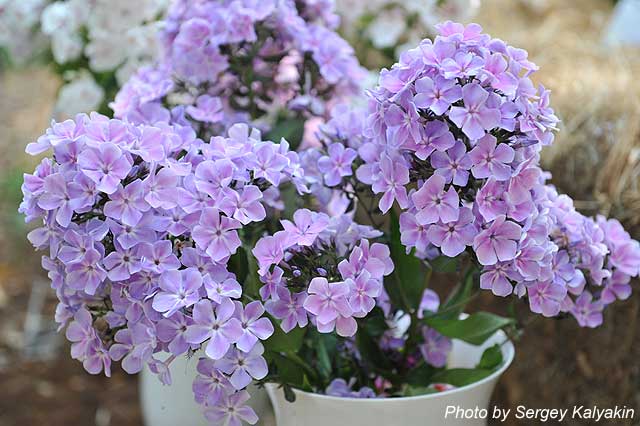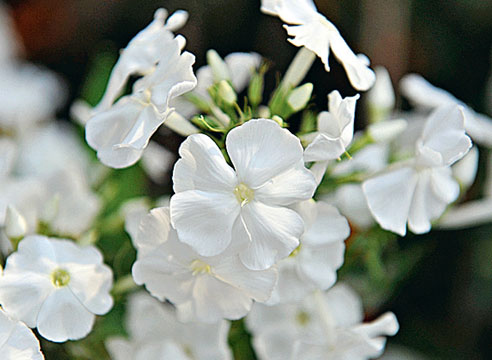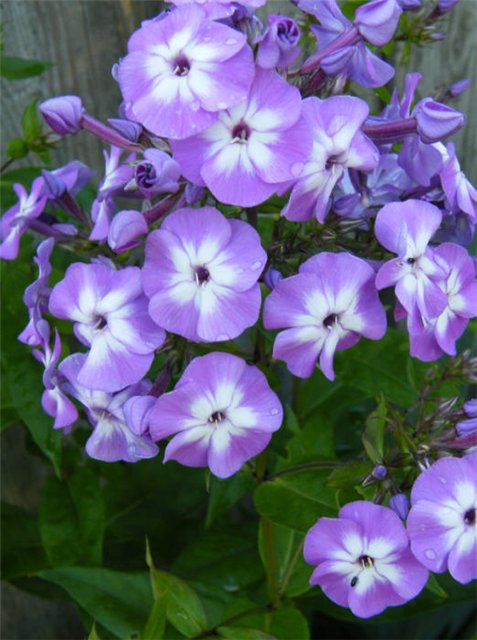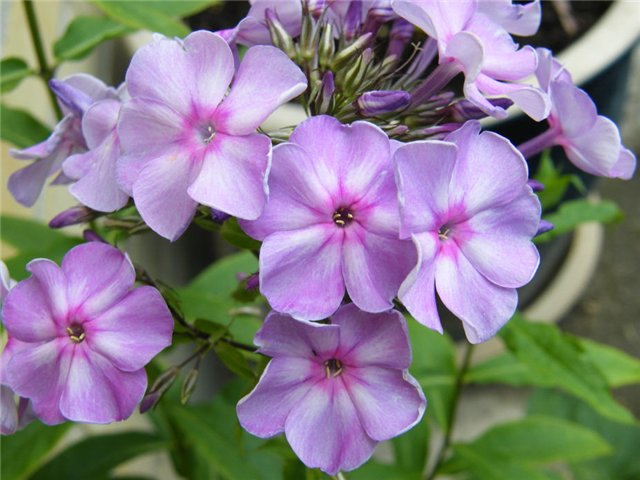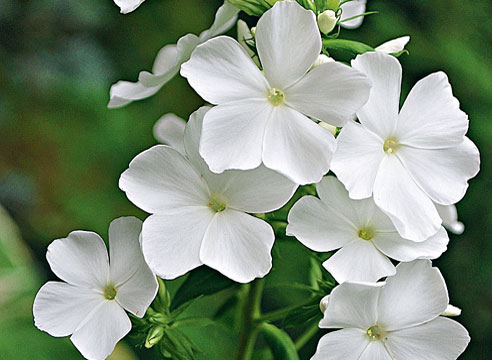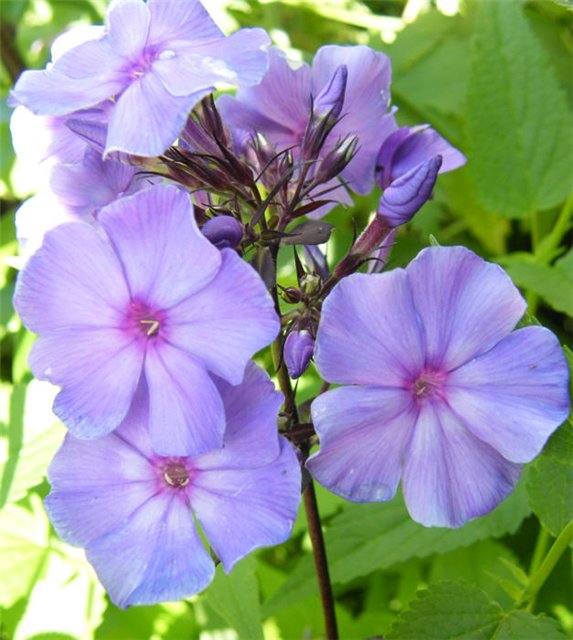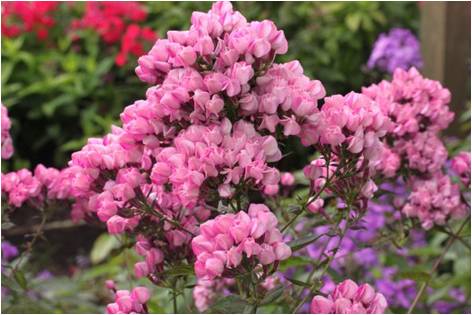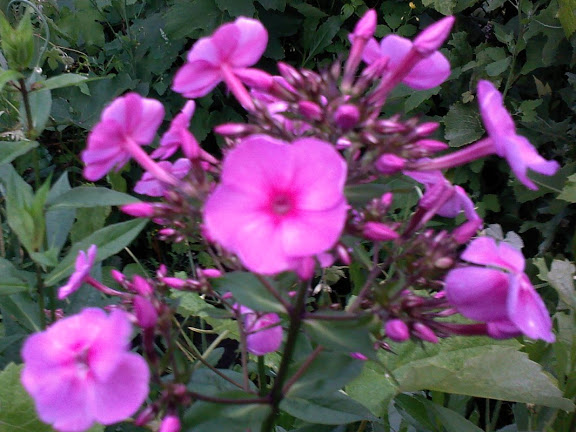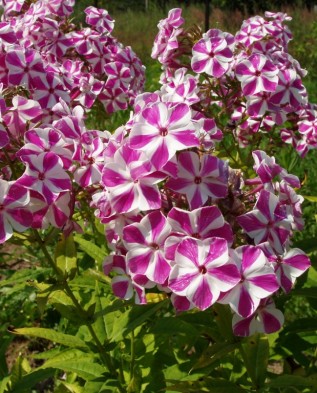Landing features
For planting paniculata phlox, it is better to choose a place protected from strong gusts of wind, sunny or slightly shaded. In hot midday hours, the plant will be more comfortable in the shade of trees and large bushes. For brightly and richly colored varieties, shady areas of the garden are suitable, otherwise the delicate petals fade in the sun. The soil for this flower culture should be neutral or slightly acidic, permeable, but retaining moisture, fertile with a high humus content.
Bright, saturated phlox is best planted in the shade of trees.
Previously, the soil in the future flower garden is carefully dug to a depth of at least 30–35 cm, along the way choosing the rhizomes of the weeds and making 1 m2:
- wood ash - 60–70 g;
- garden compost or humus - 5–6 kg.
Algorithm of actions when landing:
-
They dig out planting holes 15–20 cm deep, maintaining a distance between them of about 0.4–0.6 m (depending on the height of the variety).
- A seedling is placed at the bottom of the hole, carefully straightening and spreading the roots on the sides.
- The hole is filled with soil, deepening the root collar by 5–6 cm.
- The earth is tamped around the stem so that no air voids remain between the roots.
- Spill abundantly with water.
- Mulch with peat or humus (layer 5–6 cm).
Video: planting phlox
Panicled phlox can be propagated in several ways:
-
By dividing the rhizome. The bush is removed from the ground and cut into pieces with a sharp shovel or knife (after disinfecting), in each division there should be rudiments of shoots and growth points, as well as several strong roots.
- Root cuttings. During transplantation, the upper third of the young, still non-lignified root is cut off, divided into pieces of 4–5 cm, placed at an angle in a container with a loose soil mixture (peat and vermiculite - 1: 1). When shoots appear, they are seated.
-
Stem cuttings. In late spring or early summer, before flowering, the apical shoots are cut and rooted (take the middle part with 2-3 internodes). The cuttings are stuck in the ground, covered with a jar or a cut bottle. After about a month, sprouts will appear.
- Seeds. A rarely used method in which varietal characteristics may not be preserved. Seeds are sown before winter to undergo natural stratification. Seedlings that appear in spring are planted after they acquire 3-4 true leaves. Can be sown in early spring or late winter in containers.
Phlox is easiest to breed by separating the bushes. In this case, the plants take root almost always. The main thing is to water well after planting. I try to do this in early spring, then the bushes may even bloom in the current season.
Phlox "Niki": description of the variety
The plant itself is originally from Greece, its flowers are predominantly bright red. Thanks to the painstaking work of breeders, it was possible to breed many different varieties, which are divided into two main categories: undersized and tall. Each variety has a pleasant aroma that intensifies throughout the day and only fully unfolds in the evening.
As for the "Niki" variety, it is a perennial herb. The flowering period is June-September. Flowers live for one week. On each stem, they can grow up to several dozen. As soon as they wilt, seed ripening begins, and the process of gradual withering away of the ground part of the stem also occurs. However, at this moment, the process of laying buds takes place underground, from which in the future, with the arrival of spring, new stems will begin to sprout.

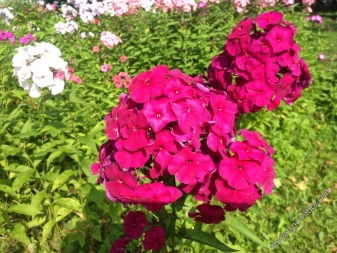
Among other features, it is worth highlighting such characteristics.
- Stem: straight and naked, can grow from 35 to 70 cm.
- Foliage: opposite arrangement.
- Flowers: The darkest shade of all cultivars (deep purple-purple) with a velvety base. Their diameter is 3.5–3.8 cm.
- Inflorescence: round-conical, medium density.
- Duration of growing in one place: 5 years.
- Location: the plant is prone to fading and it is difficult to tolerate heat and too dark places, so it is better to plant in a sunny and at the same time as cool as possible. The soil should be loose and rich in nutrients.
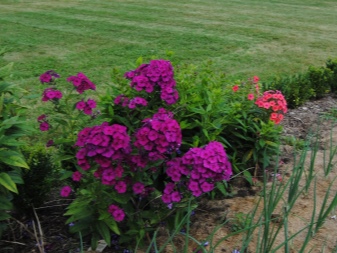

Reproduction of annuals
Annual phloxes are propagated by seeds. It was once believed that planting and caring for one-year-old phlox is a very difficult task that does not always end successfully. Not everyone was able to see how phlox sprout.
But then they drew attention to the fact that sometimes in the spring self-sown seedlings appear, the seeds of which fell to the surface of the soil in the fall and no one sprinkled them with earth. And if the rain and melted snow did not wash these seeds into the holes, they germinated successfully
Important! Phlox seeds require sunlight to germinate. Phloxes propagate in two ways
In southern regions and areas of mild temperate climates, seeds are sown directly on the soil surface. In areas with severe winters, in the mountainous regions of the Urals, Siberia, seedlings are first grown. Annual phlox plants grown from freshly harvested seeds will be disease and pest resistant
Phloxes are propagated in two ways. In southern regions and areas of mild temperate climates, seeds are sown directly on the soil surface. In areas with severe winters, in the mountainous regions of the Urals, Siberia, seedlings are first grown. Annual phlox plants grown from freshly harvested seeds will be disease and pest resistant.
Necessary conditions for growing seeds
In order to successfully grow annual phlox, you need to follow several rules:
- for sowing, only large seeds are selected from fully ripe seed pods;
- to obtain large seeds on mother plants, several stems with inflorescences and stepsons are removed, half of the buds are left in the inflorescences;
- healthy, well-developed bushes are used as a mother plant, they are intensively fed and watered.
Additional information: if the seeds do not have time to fully ripen in seed pods before the onset of cold weather, the branches with pods are cut off, tied in bunches, folded into a gauze bag and left to dry completely in a ventilated room at room temperature.
For the formation of a spherical bush and the formation of numerous lateral shoots, phloxes begin to pinch even at the seedling stage. After the appearance of 5 leaves, the top of the central stem is either cut off or pinched by hand.
Seed preparation for sowing
Dried boxes with Drummond phlox seeds are stored in a cold place - basement, vegetable compartment of the refrigerator. The seeds are not removed from the pods until they are sown. This is due to the fact that the seeds dry out quickly in the air and lose their germination.
A few days before sowing, the seeds are poured from the testes and soaked in a pink solution of potassium permanganate for 10-15 minutes. The floating seeds are thrown away, the rest are washed in running water. Then they are dried, spread on a paper towel, and planted in a nursery.
Seeds
How to sow seeds for seedlings
Phlox seeds sprout for a long time - up to 3-4 weeks. Therefore, seeds are sown for seedlings in early to mid-March. Seating boxes must have sides with a height of at least 5 cm and drainage holes. The moistened soil substrate is poured 3/4 of the height of the box. The surface of the soil is tamped with the back of a tablespoon or scoop.
The seeds are spread with a damp toothpick over the surface of the soil in rows at intervals of 3-5 cm and lightly sprinkled with a thin layer of sand. Sowing can be messy - for this, the seeds are mixed with sand and scattered over the box as it turns out.
In the boxes, they create the conditions for a mini-greenhouse: they are covered with glass or transparent plastic. Check periodically for signs of mold and pests, ventilate and moisturize.
Note! Seeds can be sown directly into individual volumetric containers, in this case there is no need for picking seedlings
What does phlox seedlings look like
After the seeds hatch, it will take at least 2-3 weeks for 2 pairs of true leaves to grow.
At this time, the plants dive - they are transplanted into more spacious boxes, they maintain a distance of 8-10 cm between the bushes.
After three months, the plants will already have 5-6 pairs of leaves and the first buds.
Young seedlings
Care
The Tatiana variety, like all phlox, prefers a sufficient amount of moisture and fertilizers. Their lack leads to the formation of small inflorescences, rapid shedding of leaves and petals.
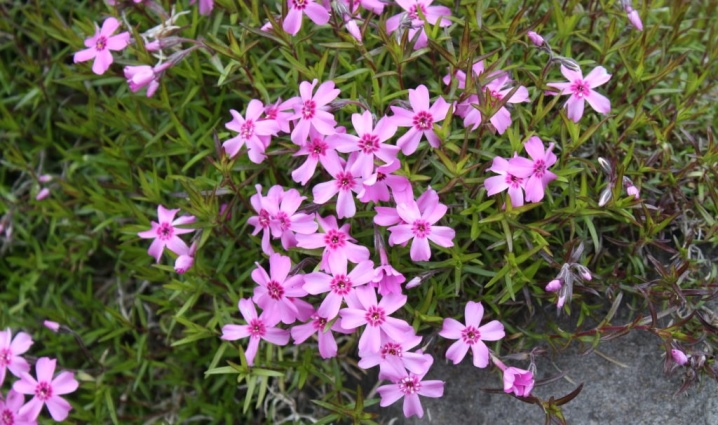
Watering
It is advisable to water in the evening - so the evaporation of moisture will be slower. Water must be poured at the root, per 1 sq. m landings will require about 2 buckets. Water for irrigation should be collected in advance so that it warms up under the sun's rays. Watering with cold water can negatively affect the stems - they can crack and the bush will lose its shape.
After watering, the soil must be loosened periodically. Weeds in a flower bed must be removed in a timely manner so that it does not oppress flower plantings.
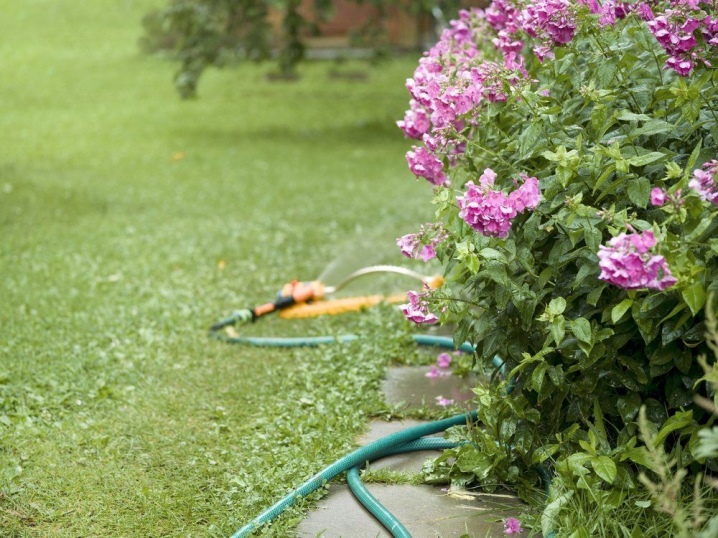
Fertilization
Flowers should be fed at least 3 times per season.
- When forming young shoots, the plant needs nitrogen-containing fertilizers. You can pour mullein infusion or herbal infusion (nettle is better).
- During the second feeding, during the budding and flowering period, it is advisable to add potassium sulfate (10 g per 10 l of water) or add ash. It can be poured directly under the bush in a dry form (1 handful), but it is better to dilute it in a volume: 1 glass per 10 liter bucket of water.
- For the period of seed boll formation (when the flowering time ends), there are 3 additional fertilizing. The plant should be fed with phosphorus-potassium mixtures (15-20 g of superphosphate and 10 g of potassium sulfate per 10 liters of water).
Preparing for winter
At the end of October-November, when cold weather is established, it is necessary to trim the stems of paniculate phlox. You can cut at the root, but it is better to leave 1-3 cm from the ground. The stems and soil around the bush must be treated with fungicides to prevent disease. Copper sulfate is well suited for these purposes. The cut stems are burned.
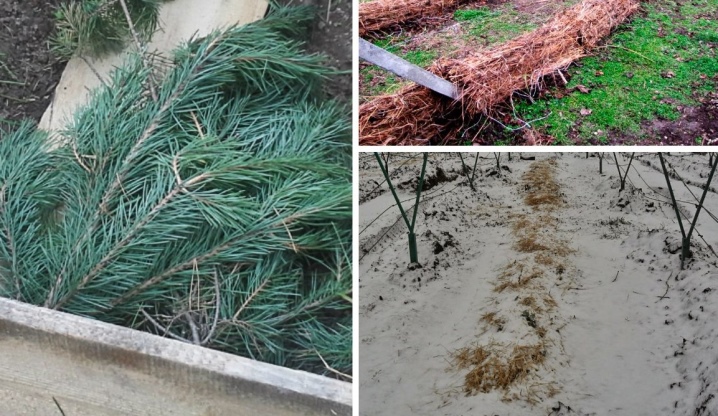
Varieties
"Aurora" - the flower is almost white, has a pale pink tint, looks like white in the flower garden. The shape of the flower is stellate. Diameter 2.4 cm. Forms carpets high 12 cm - real white drifts.
"Amazin Grace" - ve (‘Amazing Grace’) -the flower is white with a bright carmine-purple eye. Diameter 1.8 cm. Forms carpets with a height of 12 cm.
"G. F. Wilson "(‘ G. F. Wilson ’) - a light lavender-blue flower, star-shaped. Diameter 1.8 cm. Forms carpets up to 20 cm high, is considered one of the strongest varieties. Branches profusely, reproduces well. Widespread in green building.
"Thumbelina" (‘Dujmovotcshka’) is a rich cold pink flower with a dark carmine eye. Diameter 1.6 cm. Forms carpets 10-15 cm high. The leaf is dark green. Growing rapidly.
"Coral Ai" (‘Coral Eye’) is a light pink flower with a carmine eye, star-shaped. Diameter 2.0 cm. Forms carpets with a height of 12 cm. It grows and reproduces well.
"Candy Stripes" -the flower is white with a wide pink stripe in the center of the petal in its entire length. Diameter 1.9 cm. Forms carpets 10 cm high. Abundant, lush, long flowering. It enjoys special love and popularity due to its unusual original memorable color. It resembles a variety of paniculata phlox "Mishenka".
"Maischnee" - a snow-white flower, beautiful wheel-shaped. Diameter 1.5 cm. Forms carpets with a height of 8-10 cm.One of the most beautiful and common white varieties. Against the background of bright plants, it truly dazzles with its whiteness.
"Nettleton Variegata" (‘Netteleto Variegata’) is a pink flower. Diameter 1.7 cm. Forms carpets 10 cm high. Valued as variegated variety. Leaves are dark green with a whitish-pink border; the border turns bright pink in the sun. It can be used as an ornamental plant to decorate any flower arrangements.
"Tellaria" (‘Tellaria’) - lilac flowers with a carmine eye, star-shaped. Diameter 2.3 cm. Forms carpets 12 cm high. Differs in very long flowering.
"Temiscaming" (‘Temiscaming’) - the flower is very bright, dark crimson-purple. Diameter 2.0 cm. Forms carpets with a height of 15 cm. Differs in strong growth, active branching of stems and dense sod. Beautiful dark with red leaves. Propagates well by cuttings. One of the most purchased varieties since 1956.
Also found on sale:
- 'Appel Blossom' - pink flowers;
- ‘Atropurpurea’ is undersized, with dark carmine pink flowers with a dark eye.
- ‘Avalanche’ —white;
- ‘Daisy Hill’ — pink flowers;
- ‘Leuchtstern’ - pinkish-reddish flowers. The pillows are very thick.
- ‘Moerheimii’ - pink flowers with red eyes;
- ‘Ronsdorfer Schone’ - salmon pink flowers;
- ‘Samson’ - bright pink flowers;
- ‘Thomasini’ - purple-blue flowers;
- ‘Vivid’ - flowers are dense pink, round. The turf is dense and grows well. One of the best varieties.
- 'White Delight' - white flowers, grow well, one of the best varieties.
Types and varieties
The plant is divided into bush and ground cover species.
Low-growing perennial
Creeping or ground cover bushes can have stems from 5 to 40 cm long. They grow well in width, therefore they are often used to decorate an alpine slide. The most popular undersized phlox are the following varieties:
- Forked. A plant with slightly pubescent stems and an unusual shape of flowers. The petals of the buds are dissected, which makes it seem that this is not one, but several flowers. The color of the inflorescences is mainly blue and white.
- Douglas. A bush up to 10 cm high is distinguished by a dense cushion of flowers that are located on rigid stems. The color can be purple, white, lilac. Flowering lasts from May to June.
- Phlox subulate. Popular undersized plant with stems up to 18 cm long. When planted in open ground, subulate phlox covers a large area of soil with purple, white or pink inflorescences. The first flowering of the plant is in May-June, after which, in August and September, beautiful numerous flowers bloom again on the bush.
Bush perennial
Plant bushes are the most common, and they are most often used to decorate flower beds in the garden. They are short - up to one meter high and tall - more than a meter high.
Low-growing varieties:
- Orange Perfection is a variety with salmon-colored buds that appear pink in the bright sun.
- Tiara is an unpretentious and beautiful plant with emerald greenery, against the background of which the inflorescences stand out with their snow-whiteness.
- Sherbet Cocktail is a fast-growing shrub with olive-colored flowers.
Tall varieties:
- Magic Blue is a variety that blooms with scarlet, blue, lilac or white flowers that bloom in early summer and adorn the garden until September.
- The tenor is an abundantly flowering plant with bright purple-red inflorescences.
- Nicky is a perennial bush up to 1.2 meters high. At the beginning of summer, dark saturated flowers bloom on it, which fade only in September.
- Natasha is a plant up to one and a half meters high with blue and white buds.
- Windsor is a one and a half meter bush, distinguished by elongated oval-shaped leaves and inflorescence color from white to carmine.
Types and varieties of perennial phlox (with photos and names)
To choose a variety, look at the photos in the catalog with names. Different types of perennial phlox are not similar to each other, but are equally easy to care for.Plants can be distinguished by species characteristics:
The perennial subulate phlox vaguely resembles a carnation. Unpretentious to the soil, can grow in rocky or sandy areas.
Phlox Douglas is slightly lower, bushes are easily separated from each other. The palette of inflorescences varies from white and blue to dark red (see the photo for a variety of perennial flowers, among which are phlox).
The splayed phlox has a delicate and delicate aroma. Its stems are very flexible and take root easily.
Stolon-bearing phlox weaves strongly. It is a sun-loving plant that grows 26-30 cm in height. Blooms profusely in early summer.
Panicled phlox. It can be seen more often than other species on the site. Unpretentious, frost-resistant, has a pleasant smell and bright inflorescences.
Spotted phlox. In America, it is considered wild, its glossy leaves are covered with brown stripes, the inflorescences are small. Doesn't need any special care.
Drummond's annual. It has a bright color and a long flowering period. The only species with a yellow color in the color palette.
This is an incomplete list of plant species that can be used to decorate flower beds and lawns.
Of the plants that form a pillow or dense bushes, phlox are the most common:
Douglas (Ph. Douglasii); Subulate (Ph. Subulata);
Pleasant (Ph. Atoepa); Spread (Ph. Divaricata) and their varieties.
Less common are white-flowered compact phlox, for example:
Spike-leaved (Ph. Spiculifolius) and rosaceous (Ph. Roseiflora).
In terms of species composition, they are more modest than spring ones (there are only two species - paniculate (Ph. Paniculate) and spotted (Ph. Maculata), but the varietal diversity is amazing. Now both famous domestic varieties and the newest foreign ones with variegated leaves are very popular. mods - plants with pseudo-double flowers (series 'Feelings').
See what a variety of varieties of perennial phlox exists in the photo:
In addition to the appearance, you should pay attention to the seedling.
Planting and caring for a splayed phlox
To grow a beautiful splayed phlox (pictured), you must follow the simple planting and care rules, which are described below. The plant is unpretentious, so both experienced summer residents and novice amateurs will cope with it.
Landing rule timing
There are two planting dates for splay phlox:
- Spring - late April or early May.
- Autumn is the last decade of August or early September.
The specific period is chosen depending on the climatic conditions of the region: in the south, you can start 1-2 weeks earlier, and in the Urals and Siberia - a few days later. Moreover, in the case of an autumn planting, the phlox stem should be immediately shortened by a third - this is necessary for a comfortable wintering.
There are no special requirements for the flower bed. It can be located both in the sun and in partial shade (strong shading is undesirable). If possible, the site should be protected from strong through winds. The soil is sandy loam or loamy, loose, moderately fertile. Stagnation of moisture is undesirable, therefore, in the lowlands, spread-out phlox, like many other flowers, should not be planted.
The basic rule for planting is to maintain a distance of 25-30 cm. It is this interval that will allow you to get a lush floral carpet. Sequencing:
- The site is cleared of debris and weeds in advance.
- The soil is dug to a shallow depth.
- Close up 3-5 kg of humus or compost per 1 m2.
- Several shallow holes are formed before planting.
- A spread-out phlox is planted, covered with turf soil.
- Water and mulch with peat, humus.
Follow-up care
Even minimal maintenance of the splayed phlox produces lush flowering carpets that adorn the garden at the beginning of each summer. Caring for a plant comes down to several actions:
- Watering is regular. Moreover, it is better to give a little water, but often. The fact is that the root system of phlox is superficial.Therefore, if there is no rain or it is weak, then water is watered with settled water 2 times a week, and in drought - 3-4 times.
- The day after rain or irrigation, the soil in the flower bed must be loosened. This prevents crust formation and soil compaction.
- Top dressing is applied periodically (preferably every 2-3 weeks) throughout the season from May to August. They use a complex mineral fertilizer and liquid organic matter, for example, an infusion of mullein or poultry droppings. These compositions should be alternated. The last top dressing must be applied no later than the end of August, and it should not contain nitrogen compounds.
- The roots should be mulched immediately after planting the spread phlox. Then the soil will retain moisture longer.
- Weeding should be carried out as necessary, since weeds interfere with the growth of the main crop and spoil the appearance.
For abundant flowering splay phlox are fed 3-4 times per season
Preparing for winter
The main activity in preparing for winter is pruning. Many growers do not do haircuts, as splay phlox bushes grow relatively evenly. In autumn (at the beginning of October) it is better to cut the bushes at the root or leave 10 cm high shoots. The removed branches should be taken away and burned.
The rest of the plant needs to be watered one last time and sprayed with any fungicide. At the same time, a small pinch of wood ash and an incomplete tablespoon of superphosphate are poured under each bush. Spruce branches, hay, dry leaves and other mulch are placed on top. The layer should cover the culture.
The need for a transplant
Split phlox grow in the same place for 5-7 years. During this time, they grow well and fill the entire space. Then it is desirable to separate the bushes. To do this, they are dug out in early spring or autumn and get several divisions, which are planted in a new flower bed with an interval of 25-30 cm. The mother bush can be left in the same place or transferred to a new site.
Landing
A luxurious perennial grows in one place for up to 8 years. All this time it blooms profusely. Then, in order to preserve the decorative effect of the flower, the gardener needs to divide or transplant the bush. The Gzhel variety tolerates a similar procedure well
It is important to adhere to the basic rules for planting phlox
Timing
The optimal time for planting should be chosen depending on the region. If phlox is grown in warm areas, it is early fall. The crop starts growing early, immediately after the snow melts. Therefore, the moment when the roots did not grow, and the earth has already thawed, is easy to miss. Planting the Gzhel variety in the middle lane is recommended to be postponed to spring. If the perennial does not have enough time to take root, then the bush will die in winter. Especially if the winter is snowless. Planting time for colder areas is May.
Landing algorithm
Before starting the procedure, several conditions must be met:
- Decide on a place. Phlox Gzhel is preferable to plant in a lighted area. At the same time, the variety does not tolerate sunshine. Grows well in openwork shade.
- Prepare the ground. The soil should be fertile and loose with a slightly acidic reaction. In case of an acidic reaction, pre-lime. If there is loam on the site, this is the best option for the variety. Before planting, dig the bed to the depth of the shovel bayonet. Dig holes according to the size of the root system of the seedling with a slight increase, but not less than 20 cm in depth.
After preparing the site, you should inspect the Gzhel phlox seedlings. Remove damaged, dry or broken stems and roots. Now you can start planting:
- lay a drainage layer of broken brick or crushed stone on the bottom of the pit;
- add 0.5 cups of wood ash and 20 g of superphosphate;
- add nutritious soil to 1/3 of the volume;
- pour water;
- after absorbing moisture, put a seedling, spread the roots, sprinkle with earth;
- slightly compact the planting site, re-water.
Important! Leave the root collar 3-4 cm above the soil surface.
When planting several bushes of the Gzhel variety, it is necessary to leave 50-60 cm between them. If it is windy on the site, then it is better to tie up young phlox seedlings to a support.
It is best for young plants to choose a place protected from the wind.
How to properly care for phlox
Phlox loves moisture very much, its lack in the soil noticeably affects the well-being of plants. This is due to the structure of the root system, consisting of thin branching shoots, located at a depth of only 15 cm. The soil under the plants should be moist all the time. With a lack of water, phloxes do not grow to varietal marks, the flowers become small, and the inflorescences are not so lush.
The irrigation rate is considered to be 15-20 l / sq. m. It is better to add water in the evening and always at the root
It is also important to loosen and mulch the soil after each watering. In addition to moisture, tall varieties of phlox require the installation of supports
Advice! After watering, remove unwanted plants from beds and phlox beds. Weeds not only spoil the look of your garden, but are also a source of diseases for ornamental plants.
With the onset of frost, perennial phlox is pruned almost at the root. For the winter, they are wrapped or transferred to unheated greenhouses. If phloxes remain outside for the winter, then several crystals of copper sulfate are thrown into the middle of the bush. Annual varieties are removed from the site completely. Obsolete plants should be burned.
The soil is slightly acidic or neutral, sandy loam. Phloxes are responsive to fertile soils, so when planting, you can add humus, ash or mineral fertilizers with nitrogen content. When planting, deepen the cut by 3-4 cm.
Watering.
Phloxes are moisture-loving, but do not like stagnant water. Often it is the waterlogging of these plants that leads to powdery mildew disease. When planting, make sure that there will be no stagnation of water in the spring after the snow melts. In the summer, watering at the root should be regular and abundant.
Top dressing.
Lush flowering of phlox is not so difficult to achieve using top dressing. It is recommended to feed three times a season at a strictly allotted time. The first time we feed phloxes in the spring during the regrowth of shoots with nitrogen-containing or complex fertilizers. The second feeding occurs at the beginning of summer during the budding period with complex or phosphorus-potassium fertilizers. And the final feeding with phosphorus-potassium minerals already without nitrogen is done after flowering, which prepares the plant for wintering. We use organic matter in the form of rotted compost, manure only in spring or when planting.



